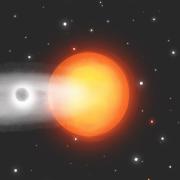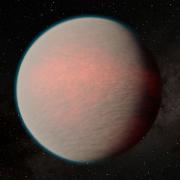For centuries, no one knew if we were alone in the universe—or if there were even other planets like ours.
But thanks to new telescopes and methods in the past decades, we now know there are thousands and thousands of planets out there circling faraway stars, and they come in all sorts of shapes and sizes—large and small, rocky and gaseous, cloudy or icy or wet.
A study by scientists with the University of Chicago, the University of Michigan and the University of Maryland suggests another for the list: planets with helium atmospheres. Moreover, the discovery may suggest a new step in our understanding of planet evolution.
Their simulations found that it’s likely that helium would build up in the atmospheres of certain types of exoplanets over time. If confirmed, this would explain a decades-long puzzle about the sizes of these exoplanets.
“There are so many weird and wonderful kinds of exoplanets out there, and this finding not only adds a new kind but may have implications for understanding the evolution and formation of planets in general,” said University of Chicago astrophysicist Leslie Rogers, a co-author of the new paper published in Nature Astronomy.
Mystery of the radius valley
It took us so long to find faraway planets because even the biggest are far outshone by the stars they orbit. So scientists came up with an ingenious way to spot them: by looking for the dip in the light of a star as a planet passes in front of it. This tells you how large the planet is.
Now we know planets are incredibly common. In fact, from what we can tell so far, at least half of all stars like our sun have at least one planet between the size of Earth and Neptune that orbits very close to the star. It’s hypothesized these planets have atmospheres with a lot of hydrogen and helium, collected when the planets first formed out of gas and dust around the star.
But as the scientists looked at the numbers of these kinds of planets, they noticed something curious—the planets were separated into two populations. One group was about the size of one-and-a-half Earths, and one group was twice the size of Earth or larger, but there were almost none in between.
This gap between the two populations of planets is known as the “radius valley,” and it’s a hotly debated question in the field. Scientists think the answer will help us understand how these and other planets form and evolve over time.
Some proposed the explanation for this gap might have to do with the planets’ atmospheres. It’s tough being a planet close to your star; you’re constantly bombarded with X-rays and UV light, which could strip away your atmosphere.
“For example, perhaps the smaller set of planets entirely lost their atmospheres and just exist as rocky cores,” said the study’s first author Isaac Malsky, a PhD student at the University of Michigan who first began exploring the question with Rogers for his undergraduate thesis at the University of Chicago.
A team including Rogers and Malsky, decided to look more closely at this phenomenon, known as atmospheric escape.
They created models based on the data we do have about the planets and the rules of physics, in order to more fully understand how the heat and radiation would affect planet atmospheres. Then they created 70,000 simulated planets—varying the size of the planets, the type of star they orbit, and the temperature of the atmosphere—and modeled what would happen to them over time.
The team found that after several billion years, the hydrogen in planetary atmospheres likely escapes faster than the helium. “Hydrogen has a lower atomic mass, so it’s easier to strip away,” explained Malsky.
Over time, this results in a buildup of helium—simulations suggested helium could make up 40% or more of the mass of the atmospheres.
Telescope confirmations
The team suggested a way to confirm their results observationally. The recently launched James Webb Space Telescope and other powerful telescopes can get a reading of the atmosphere’s elements and their amounts. The telescopes could check to see if there is an unusually large amount of helium in the atmospheres of some of these planets.
If the theory is correct, these planets with helium-rich atmospheres should be especially common at the lower end of the larger-radius group, because the helium builds up as the planet starts to shrink over time as its atmosphere is gradually stripped away.
The two distinct planet-size groups are created because even a small amount of helium and hydrogen makes for a very puffy atmosphere that can inflate the radius of the planet significantly, Malsky explained. If they have any atmosphere at all left, they’ll be in the larger-radius group; if it’s gone, they’ll be in the smaller-radius group.
None of these planets are thought to be good candidates to harbor life—they are broiling hot, bombarded with radiation, and the atmospheres are likely at very high pressure.
But the scientists explained that improving our understanding of the processes that drive the formation of planets can help us better predict what other planets are out there and what they look like, as well as directing the search for more hospitable planets.
“Getting a better understanding of this population could tell us a lot about the origins and evolution of sub-Neptune-size planets, which are clearly a common outcome of the planet formation process,” said Rogers.
The other study authors were Nadejda Marounina, then a postdoctoral scholar at the University of Chicago and now with ETH Zurich, and Eliza M.-R. Kempton of the University of Maryland. The study used resources of the UChicago Research Computing Center.
Citation: “Helium-enhanced planets along the upper edge of the radius valley.” Malsky et al, Nature Astronomy, Nov. 17, 2022.
Funding: Michigan Space Grant, National Science Foundation, Research Corporation for Science Advancement Cottrell Scholar Award, NASA.

